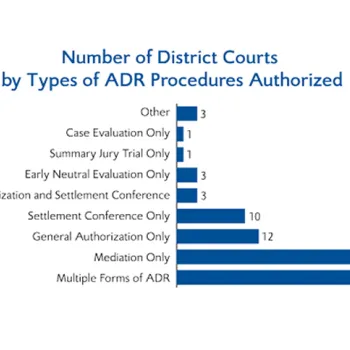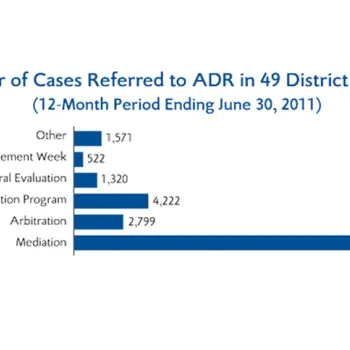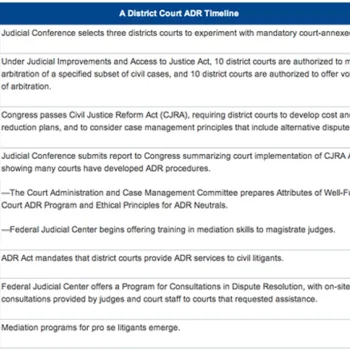Some 30 years after the federal district courts started experimenting with alternative dispute resolution (ADR), more than one-third of all federal trial courts authorize multiple forms of ADR, and all federal courts authorize some form of ADR, according to a study by the Federal Judicial Center.
A survey of courts' local rules, general orders, internal operating procedures, and other online and written sources shows that 34 of the 94 district courts authorize multiple and distinct forms of ADR, typically mediation, arbitration, or early neutral evaluation (ENE). Of these courts, fourteen authorize three or more distinct forms of ADR. An additional 27 districts authorize mediation only, while 25 districts provide general authorization to use ADR, authorize settlement conferences, or authorize both.
Across the district courts, the most commonly authorized form of ADR is mediation, authorized by 63 of the 94 districts. Twenty-three districts authorize use of ENE and 23 authorize use of arbitration. Of the ten courts authorized by the Judicial Improvements and Access to Justice Act of 1988 to mandate arbitration, only three continue to require use of arbitration for the full portion of their caseload that meets the statutory requirements, while also offering mediation programs. Four others have made arbitration an ADR option. Three no longer authorize this procedure.
According to the FJC report, the majority of districts authorize some degree of required use of ADR, particularly for mediation and early neutral evaluation, either by giving judges the authority to refer cases on their own initiative without party consent, or by mandating referral for some or all civil cases. For mediation, for example, 58 districts authorize required use of mediation, including 12 that mandate use for some or all civil cases.
The most recent development in ADR is the emergence of mediation programs for pro se litigants, which appear to have been established for non-prisoner pro se litigants in 18 districts and for prisoner pro se litigants in 11 districts. Many of these mediation programs are new or experimental and have not yet been incorporated into local rules or other ADR documents.
While the referral numbers and the profile formed on the basis of authorized procedures provides helpful information, the FJC report notes that its summary of ADR activity in the district courts is preliminary.
In the following months, the FJC will be following up on this initial report in the hope of providing answers to some of the remaining questions, such as the number of cases disposed of by ADR, and ADR's impact on court caseloads and judicial workloads.
In addition, the FJC report includes information about the types of persons authorized to serve as ADR neutrals, the compensation of ADR neutrals, and the overlap of compensation and participation requirements. Read the entire report here (pdf).
Subscribe to News Updates
Subscribe to be notified when the news section is updated.



